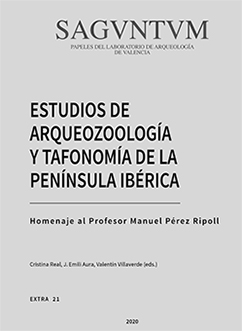Patrones de subsistencia de los grupos mesolíticos en la Cueva de El Mazo (Asturias)
Palabras clave:
arqueozoología Resumen
Resumen
The subsistence of hunter-gatherer-fisher groups during the Mesolithic in the Cantabrian coast is characterized by a wide diversity of exploited resources, including mammals (marine and terrestrial), birds, fishes, marine molluscs, crustaceans and echinoderms, but above all it is remarkable the intensification in the exploitation of some of these resources, such as the marine molluscs, in parallel to particular changes in the exploitation of terrestrial mammals, specifically ungulates. Recent excavations in the shell midden of El Mazo cave (Asturias), with a continuous stratigraphic sequence that covers most of the the regional Mesolithic (8.9 to 7.6 cal ka), have provided a significant amount of biological remains. Here, the archeozoological and taphonomic study of the macromammal remains from the stratigraphic units 100 to 107 is presented. The results show the palaeoconomic decisions adopted by those human groups, their diet and exploitation of different ecological environments, seasonality of the occupations and, also, reveal the different biostratinomic and diagenetic alterations that took part during the formation of the shell midden.
 Descargas
Descargas
Descargas
Publicado
Cómo citar
-
Resumen408
-
PDF249
Número
Sección
Licencia

Este obra está bajo una licencia de Creative Commons Reconocimiento-NoComercial-SinObraDerivada 4.0 Internacional.
Con la publicación impresa de los trabajos, los/as autores/as aceptan que el Departament de Prehistòria, Arqueologia i Història Antiga de la Universitat de València pueda permitir la difusión y el libre acceso a través de las direcciones electrónicas y enlaces del editor/a.
El contenido de los trabajos es responsabilidad de los/as autores firmantes y no expresa la posición ni la opinión del Consejo de Redacción.
Las obras que se publican en esta revista están sujetas a los siguientes términos:
1. La revista conserva los derechos patrimoniales (copyright) de las obras publicadas, y favorece y permite la reutilización de las mismas bajo la licencia indicada en el punto 2.
2. Las obras se publican en la edición electrónica de la revista bajo una licencia Creative Commons Reconocimiento-NoComercial-SinObraDerivada 3.0 España (texto legal). Se pueden copiar, usar, difundir, transmitir y exponer públicamente, siempre que se cite la autoría, la url, y la revista, y no se usen para fines comerciales.
3. Los/as autores/as están de acuerdo con la licencia de uso utilizada por la revista, con las condiciones de auto-archivo y con la política de acceso abierto.
4. En caso de reutilización de las obras publicadas debe mencionarse la existencia y especificaciones de la licencia de uso además de mencionar la autoría y fuente original de su publicación.



